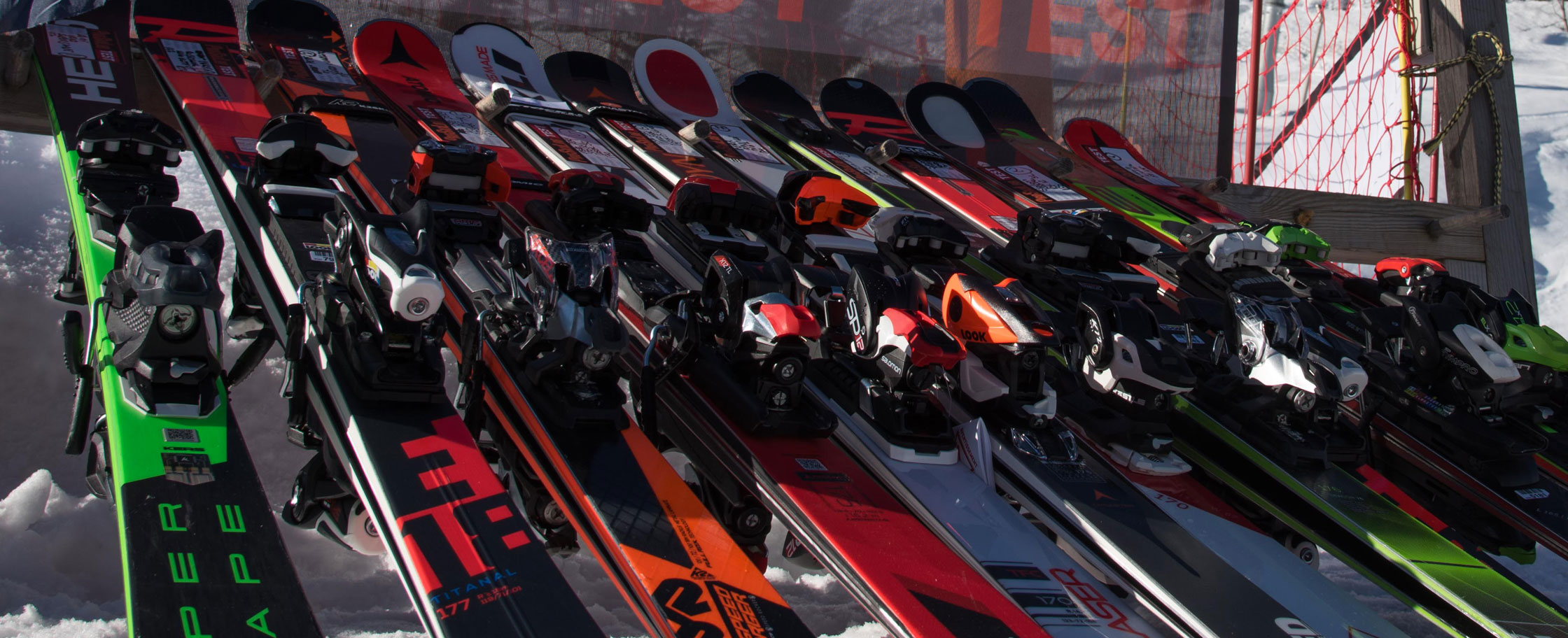
Why did you create the PROSKILAB test?
We created the test in 2006 to add a buyer's guide to our site Sports-hiver.com in France and to its European counterparts. The quick success of the test encouraged us to give the test a name and a dedicated website.
What do you mean by "Buyer's Guide?"
A "Buyer's Guide," is, first and foremost, an impartial and reliable guide that can help an internet user to choose a pair of skis. As a skier and regular buyer, I wanted a review that skiers could count on.
What was your first priority?
The first thing we had to do was develop a methodology: analyze skiers' needs, divide them into different categories, determine criteria for each category, define test conditions, etc.
Then we had to find a location for the test, recruit a team of testers, etc.
How did you choose the test location?
We needed a ski resort where we would find all types of conditions, orientations, and slopes. In addition, we wanted a resort that met our logistic needs: a secure place to store the skis, easy access to the base of the test, etc. In the beginning, we organized the test in Chamonix, then in Les 2 Alpes, and for the last several years in La Clusaz in the Haute Savoie (France).
How do you recruit the testers?
We wanted most of them to be experienced professionals capable of pushing a ski to its limits and of analyzing its performance. So, we recruit seasoned professionals, ski instructors, and/or high mountain guides. They usually have excellent technique, are specialists in their field, or are former racers.
Why do you emphasize the fact that the PROSKILAB test is a "comparative" test?
All skiers know that the ranking of a ski may vary depending on the weather, the skier, the snow conditions, etc. Testing one ski on Monday and then a competing model on Thursday, in different conditions, by other testers, doesn't make any sense in our opinion. Therefore, we decided that the skis would be tested by the same panel of testers on the same half-day to have relatively consistent test conditions. This reduces the number of models tested considerably but ensures the quality of the testing process.
How do you organize the week of the ski test?
We start by making a list of the skis we received and labelling each ski with a sticker. We also look at the weather. The schedule for the week is determined by the criteria of each category, the snow conditions, and the availability of the testers. The categories with stricter criteria are given priority. For example, "performance-oriented' skis have to be tested on hard snow, and all-mountain skis have to tested in powder.
What happens if there is no powder?
This is rare, but unfortunately it happens. We keep the skis for a few extra weeks and then organize a second session.
You mentioned that the skis were preselected. How does that work?
Our commitment to perform a comparative test, as described earlier, puts us under a lot of pressure. In fact, for a given category, a team of 6 testers can only test 6 to 8 skis in a half-day period. There is even more pressure with all-mountain and freeride touring skis, which require more time to test. They must be tested on piste as well as off-piste. When the conditions require it, we sometimes have to take our skis off and go further afield in search of virgin powder!
Consequently, we have to choose the skis that will be included in the test in advance. Our goal is to offer the best selection possible given the criteria of each category, while taking into account any new technology or commercial restrictions of the brands. Whenever possible, we pre-test skis before including them in the test. This phase lasts 3 days in January.
In general, the skis chosen prior to the test are high-quality skis.
How do you choose the brands?
We don't choose brands, only skis. Some brands are not tested simply because they don't have any skis that adequately fulfill the criteria of our categories. For example, this is often the case with brands specializing in freeride skis.
Certain ski reviews take price into consideration. Why doesn't PROSKILAB?
We purposely exclude the price factor, even though it is obviously important for the final consumer. Our goal is to try to find the best skis on the market. The price of skis varies greatly throughout the season and it is impossible to include it in an objective way. Therefore, it is up to the internet user to make the best choice taking into account the prices offered by retailers in the "Where to buy this ski" sections.
What is at stake in a test for a brand?
For the manufacturer, launching a ski requires a lot of work, a considerable investment, and obviously, high sales expectations. In addition, the test results definitely have a profound influence on sales. For example, a "Best Ski" award from PROSKILAB has a significant impact on sales (as measured by the number of clicks on advertising links). The economic stakes are therefore very high.
We finance the review through clicks made by internet users on links to retailers in the "Where to buy this ski" section, which is managed by the Gearscore platform.
From the outset, we decided that the test would refuse any commercial or advertising relationship with the brands in order to preserve our editorial freedom. This was also a specific request from certain brands.
We are pretty firm on this matter. We do not accept any gifts or benefits of any kind from the brands. I pay for my skis like any other consumer.
Are some brands better than others?
Over the long term, no. The analysis of PROSKILAB test results shows that the best-ranked brands seem to take it in turn to lead the innovation process.
One or several brands may take the lead in a category because of certain skis which dominate one segment of the market. But that only lasts a few seasons, and the competitors come back with improved models.
How do you view the technological innovation of the brands?
Of course, we try to take a step back from any of the brands' technical and marketing discussions. There is true innovation, "fashion" trends, and marketing speak. These are three very different things. The test allows us to try the skis on actual ski terrain and put things in perspective.
How are your relationships with the brands?
They vary based on the results of the tests. When the models have good reviews, our relationships are generally good. When this is not the case, the relationships can be quite strained.
Do certain brands put pressure on the ski test?
We were never pressured to change a score or an award after the test. However, in general, pressure does exist and this is to be expected given the stakes involved. As we do not rely on the advertising budgets of the manufacturers, the brands sometimes resort to other measures. Some brands leave the test and then gradually come back after time.
How do you deal with this?
There aren't many options. Either you perform a discriminating test that helps skiers, working with brands who are willing to play by the rules, or you do a test that makes everyone happy, but then the review looks more like technical and marketing material and leaves the consumer indecisive.
We made our choice 13 years ago. We refuse to give away awards and scores. Due to the circumstances, we accept that certain brands, who are not satisfied with the test results, will decide to no longer collaborate with PROSKILAB.
Moreover, the test is very selective for the reasons explained earlier. We cannot test every brand and every model in each category, so we try to concentrate on the best skis.
Finally, it is often temporary. A few seasons later, we will begin to test the brand again when new models come out.
And then things change, sometimes dramatically. Often it takes just one model or range that performs particularly well to completely change who is in the lead. Brands that had low scores a few years ago have returned with new models and are now on the top of the podium!
How exactly does the ski test work?
The testers go off and test the skis, often in pairs so that they can exchange information and share the skis. They fill out a test card when they return to the test center. At the end of the half-day, we have a meeting and review all the skis tested. We calculate the average scores, read the opinions of each tester, and have a discussion. Then we write a summary on each ski. At the end of the meeting, the testers award the medals.
Do the testers always agree with each other?
No, not always! When there is a difference of opinion on a model, we try to understand why. There may be differences between the reviews of the professional and non-professional testers, which can usually be explained by a difference in how the ski has been used due to differences in technique among testers. There may also be discrepancies due to the different sizes of the testers. These points are discussed at the meeting. We take all these factors into account before writing a summary.
How is the "Best Ski" medal awarded?
The "Best Ski" medal is awarded to the ski that best fulfills the criteria of the category and that sets itself apart from the rest of the market by its unique qualities. They are often the models that are or will become the points of reference in their market segment.
We don't automatically award a "Best Ski" medal in each category. Sometimes, we do not award a medal if the testers don't think that any ski deserves it. Conversely, there may be several "Best Ski" medals in the same category.
Do you think that you have achieved your goal and why?
I sincerely believe that we have. We wanted a reliable test, and I think that we now have one, after 13 years of hard work.
We often receive testimonials from skiers who tell us how happy they are with the choice they made based on the test results published by PROSKILAB. These testimonials are important and always give us great satisfaction.
In addition, the number of visits to the site is another indicator of the confidence internet users have in the test. Half a million skiers visit the PROSKILAB site each year. Approximately 70,000 of those visitors click on the "Where to buy this ski" link.
What skis do you ski on?
Personally, I have a soft spot for race-inspired skis that are still accessible and for fairly stiff all-mountain skis: Völkl Mantra (2 pairs), Scott Crusade, Rossignol Hero Elite ST Ti R22, 9GS, Dynastar Mythic Rider, etc. The Elan Wingman 84 and Stöckli Laser SC are on my shopping list this year.
Were these skis tested by PROSKILAB?
Yes, they are usually skis that I really liked during the ski tests or the pre-selection sessions. If I recall correctly, almost all of them received a "Best Ski" award.


